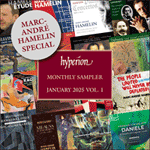
Welcome to Hyperion Records, an independent British classical label devoted to presenting high-quality recordings of music of all styles and from all periods from the twelfth century to the twenty-first.
Hyperion offers both CDs, and downloads in a number of formats. The site is also available in several languages.
Please use the dropdown buttons to set your preferred options, or use the checkbox to accept the defaults.

In the summer of 1892, Fauré began an affair with Emma Bardac, a singer married to a rich banker, who was later to become Debussy’s second wife. Mme Bardac had just given birth to her second child, Régina-Hélène, known as Dolly because she was so tiny, and five of the six pieces in this suite were written for her over a period of four years (the exception being ‘Berceuse’, which Fauré had kept in a drawer since the 1860s).
The title of the second movement, written for Dolly’s second birthday (20 June 1894), was a mistake by Fauré’s publisher Hamelle for ‘Messieu Aoul’, Dolly’s name for her elder brother Raoul, then a lively thirteen-year-old. ‘Le jardin de Dolly’, a New Year present for 1895, must be one of the loveliest tunes in the whole of the nineteenth century, while ‘Kitty-valse’, composed for Dolly’s fourth birthday, was in fact a portrait of the family dog, Ketty. After the almost adult passion unleashed in the wonderful ‘Tendresse’, in the arch Romantic key of D flat major, Fauré returns to childish sparkle in ‘Le pas espagnol’, the only example of Spanish music in his whole output. According to the pianist Marguerite Long, it was inspired by a statue of a man on a horse of which Dolly was fond.
from notes by Roger Nichols © 2021
Au cours de l’été 1892, Fauré entama une aventure avec Emma Bardac, une chanteuse mariée à un riche banquier, qui allait ensuite devenir la seconde femme de Debussy. Mme Bardac venait de donner naissance à son deuxième enfant, Régina-Hélène, surnommé Dolly car elle était toute petite, et cinq des six pièces de cette suite furent écrites pour elle sur une période de quatre ans (l’exception étant la «Berceuse», que Fauré gardait dans un tiroir depuis les années 1860).
Le titre du deuxième mouvement, écrit pour le deuxième anniversaire (20 juin 1894) de Dolly, était une erreur de l’éditeur de Fauré, Hamelle, «Mi-a-ou» au lieu de «Messieu Aoul», le nom que donnait Dolly à son frère aîné Raoul, alors âgé de treize ans et plein d’entrain. «Le jardin de Dolly», un cadeau pour le Nouvel An 1895, est probablement l’un des plus jolis airs de tout le XIXe siècle, alors que «Kitty-valse», composée pour les quatre ans de Dolly, était en fait un portrait de la chienne de la famille, Ketty. Après la passion presque adulte que libère la merveilleuse «Tendresse», dans la tonalité romantique par excellence de ré bémol majeur, Fauré revient à l’éclat enfantin dans «Le pas espagnol», seul exemple de musique espagnole de toute son œuvre. Selon la pianiste Marguerite Long, il fut inspiré par la statue d’un homme à cheval que Dolly aimait beaucoup.
extrait des notes rédigées par Roger Nichols © 2021
Français: Marie-Stella Pâris
Im Sommer 1892 begann Fauré eine Affäre mit Emma Bardac, eine Sängerin, die mit einem reichen Bankier verheiratet war und die später Debussys zweite Ehefrau wurde. Mme Bardac hatte gerade ihr zweites Kind bekommen, Régina-Hélène, genannt Dolly, weil sie so klein war. Fünf der sechs Stücke dieser Suite entstanden für sie über einen Zeitraum von vier Jahren (die Ausnahme bildet die „Berceuse“, die Fauré seit den 1860er Jahren in einer Schublade aufbewahrt hatte).
Der Titel des zweiten Satzes, „Mi-a-ou“, welcher zu Dollys zweitem Geburtstag (20. Juni 1894) entstanden war, war ein Missverständnis von Faurés Verleger Hamelle—eigentlich hätte er „Messieu Aoul“ heißen sollen, Dollys Name für ihren älteren Bruder Raoul, der zu dem Zeitpunkt ein lebhafter 13-Jähriger war. „Le jardin de Dolly“, ein Neujahrsgeschenk für 1895, ist wohl eine der lieblichsten Melodien des gesamten 19. Jahrhunderts, während „Kitty-valse“, komponiert zu Dollys viertem Geburtstag, tatsächlich ein Porträt des Familienhundes Ketty ist. Nach der fast erwachsenen Leidenschaft, die sich in dem wunderschönen „Tendresse“ in der urromantischen Tonart Des-Dur äußert, kehrt Fauré in „Le pas espagnol“—das einzige Beispiel spanischer Musik in seinem gesamten Oeuvre—zu kindlichem Glitzern zurück. Der Pianistin Marguerite Long zufolge war es von der Statue eines Mannes zu Pferde inspiriert, die Dolly besonders gefiel.
aus dem Begleittext von Roger Nichols © 2021
Deutsch: Marie-Stella Pâris
 Fauré: Nocturnes & Barcarolles Fauré: Nocturnes & BarcarollesThe Nocturnes and Barcarolles demonstrate Fauré’s art at its most personal, progressing from early lyricism to the elusive, rarefied style of the later works. Marc-André Hamelin’s performances are predictably fine, and combine exceptional subtlety ...» More |
 French duets French duetsA bewitching programme of music often associated with childhood, including favourites by Fauré, Ravel and Debussy; works which amply reward the care lavished on them by Paul Lewis and Steven Osborne in these exquisite accounts.» More |
 Hyperion sampler - January 2025 Vol. 1 Hyperion sampler - January 2025 Vol. 1 |

